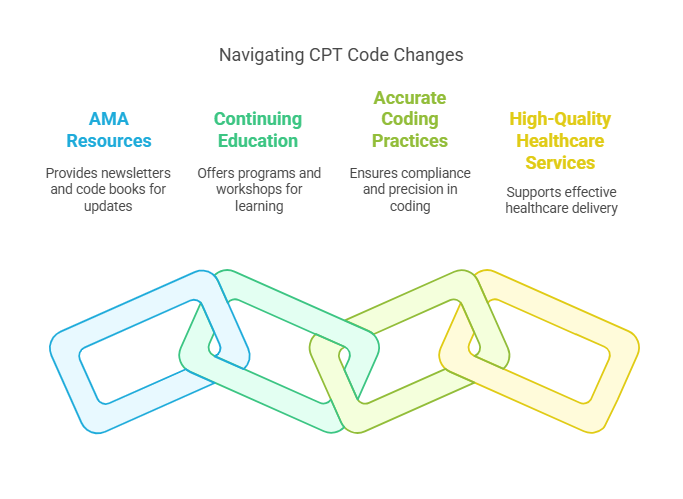Essential Guide to CPC Code Medical for Accurate Billing and Coding
A Current Procedural Terminology (CPT) code is a uniform language for coding medical services and procedures to streamline reporting, increase accuracy, and efficiency.
CPT codes are widely accepted medical nomenclature used across the country to report medical, surgical, radiology, laboratory, anesthesiology, genomic sequencing, and evaluation and management (E/M) services.
The CPT code set is developed and managed by the CPT Editorial Panel, a rigorous, transparent, and open process led by the American Medical Association (AMA).
CPT codes are used for administrative management purposes, such as claims processing and developing guidelines for medical care review.

Understanding CPT Code Categories
Category I CPT codes describe distinct medical procedures or services furnished by qualified healthcare professionals and are identified by a 5-digit numeric code.
Category II CPT codes are supplemental tracking codes used to collect data related to quality of care.
Category III CPT codes are temporary tracking codes for new and emerging technologies to allow data collection and assessment.
Category I CPT codes are the most common and widely used set of codes, while Category II and Category III codes are used for specific purposes.
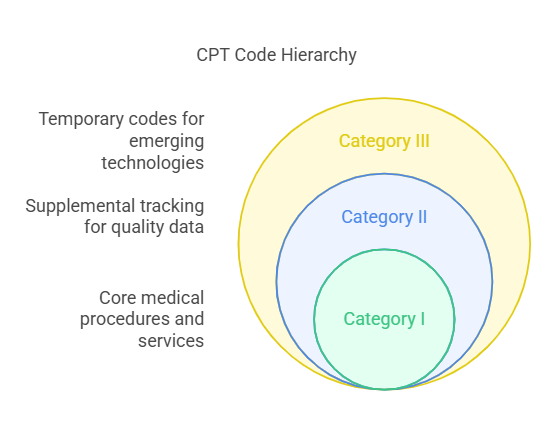
CPT Code Structure and Format
The CPT code structure and format are designed to provide a standardized way of reporting medical services and procedures, which is essential for those pursuing a medical coding and billing certification from AMBCI. Each CPT code is five characters long and can be either numeric or alphanumeric. These codes are divided into three distinct categories: Category I, Category II, and Category III.
Category I CPT codes are the most common and widely used. They describe specific medical procedures or services provided by qualified healthcare professionals. These codes are essential for everyday medical billing and coding, ensuring that routine medical services are accurately reported and reimbursed.
Category II CPT codes serve a different purpose. They are supplemental tracking codes used primarily for performance measurement. These codes help in collecting data related to the quality of care provided, which can be crucial for quality improvement initiatives and reporting requirements.
Category III CPT codes are temporary codes that describe emerging and experimental technologies, services, and procedures. These codes allow for the collection and assessment of data on new medical innovations, helping to determine their efficacy and potential for widespread adoption.
Understanding the structure and format of CPT codes is fundamental for accurate medical billing and coding, ensuring that all medical procedures are correctly documented and reimbursed.
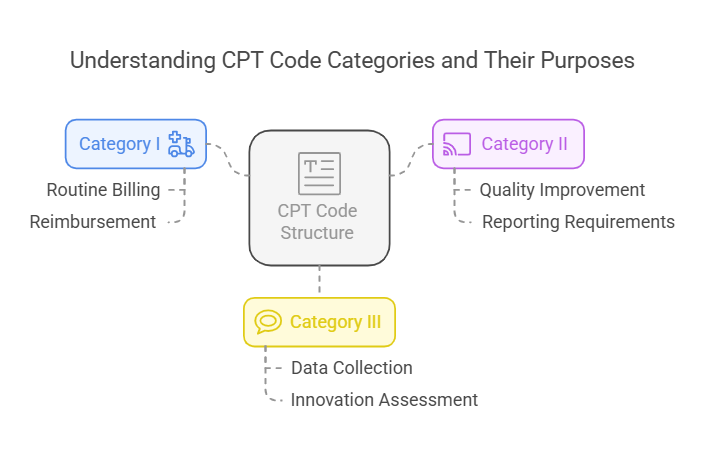
CPT Code Applications and Guidelines
The Current Procedural Terminology (CPT) code set is constantly updated by the CPT Editorial Panel with insight from clinical and industry experts to reflect current clinical practice and the latest innovations. This standardized coding system, established by the American Medical Association (AMA), provides healthcare professionals with a uniform language for documenting medical, surgical, and diagnostic services, streamlining reporting, enhancing accuracy, and facilitating administrative processes like claims processing and healthcare data management across various health insurance programs.
The CPT Editorial Panel meets three times a year to review applications for new codes or revisions to existing codes, and anyone can submit an application to attend a Panel meeting.
The CPT code set is constantly evolving to reflect changes in medical practice and technology, and is used to improve the delivery of care.
The American Medical Association (AMA) website has all the information available concerning the CPT process, access to the application forms, the schedule for the CPT Editorial Panel, and the reconsideration process forms.
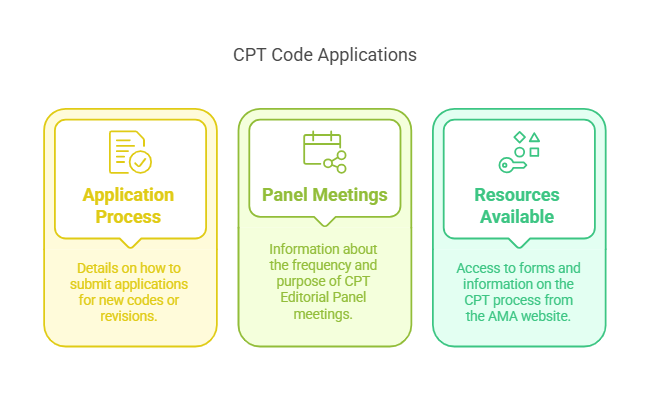
CPT Code Creation and Maintenance
The development and maintenance of the CPT code set are overseen by the American Medical Association (AMA) through the CPT Editorial Panel. This panel is responsible for updating and modifying code descriptors, coding rules, and guidelines to ensure the CPT code set remains current and relevant.
The CPT Editorial Panel meets three times a year to review applications for new codes or revisions to existing ones. These meetings are open to the public, and anyone can submit an application to attend. The panel’s decisions are informed by input from CPT Advisors, who are groups of physicians nominated by national medical specialty societies and the AMA Health Care Professionals Advisory Committee (HCPAC).
This collaborative process ensures that the CPT code set accurately reflects current clinical practice and the latest innovations in medicine. Regular updates to the CPT code set are essential for maintaining its relevance and utility in the ever-evolving field of healthcare.
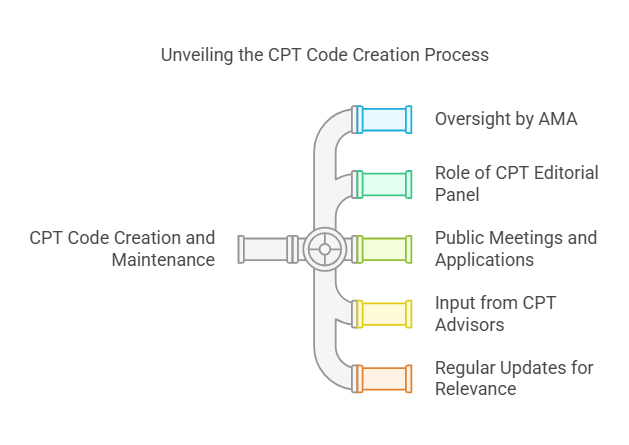
Benefits of Accurate CPT Coding
Accurate CPT coding is crucial for capturing healthcare data consistently and correctly. CPT codes provide a standardized language for coding medical services and procedures, enabling effective communication between healthcare providers, payers, researchers, and other stakeholders.
One of the primary benefits of accurate CPT coding is ensuring that healthcare services are reimbursed correctly. This is vital for the financial sustainability of healthcare providers, as incorrect coding can lead to denied claims and delayed payments. Accurate coding also supports the evaluation of healthcare utilization, helping to develop medical guidelines and conduct research.
Moreover, accurate CPT coding is essential for performance measurement and quality improvement initiatives. By using the correct codes, healthcare providers can track and analyze the quality of care they deliver, identifying areas for improvement and ensuring compliance with regulatory requirements.
Certified Professional Coder (CPC) Certification
A Certified Professional Coder (CPC) is a medical coder who has passed a certification exam administered by the American Academy of Professional Coders (AAPC).
The CPC certification exam tests a candidate’s knowledge in multiple areas related to medical coding, including anatomy, physiology, anesthesia, and medical terminology. Educational programs are available to help prepare candidates for the exam.
The job outlook for medical coders is expected to grow nine percent by 2030, according to the Bureau of Labor Statistics (BLS).
Medical coders can work in various settings, including hospitals, outpatient care centers, and physician offices.
Preparing for the CPC Exam
The AAPC has created a set of recommended steps when preparing to take the CPC exam, including completing a medical coding education program, gaining experience, and studying for the exam.
The AAPC also offers additional courses and resources to help prepare for the exam.
The exam tests a candidate’s knowledge of coding guidelines, diagnosis, and compliance, as well as topics such as anesthesia, radiology, labs, pathology, medicine, and medical terminology.
Medical Procedures and CPT Codes
CPT codes are used to describe medical procedures performed by healthcare providers.
CPT codes are an integral part of the billing process, telling insurance payers what procedures to reimburse.
CPT codes are also used to track important health data and measure performance and efficiency.
The CPT coding system is used to describe medical, surgical, and diagnostic services performed by physicians and other health care professionals. The U.S. Department of Health and Human Services designates these codes under the Health Insurance Portability and Accountability Act (HIPAA) to ensure compliance and uniformity across healthcare practices.
Common CPT Coding Mistakes to Avoid
Using incorrect or outdated CPT codes can lead to denied claims and delayed payment.
Not following CPT coding guidelines and conventions can result in incorrect coding and reimbursement.
Not staying up-to-date with CPT code changes and updates can lead to coding errors and compliance issues.
Not using the correct CPT code modifiers can result in incorrect reimbursement and denied claims.
Staying Up-to-Date with CPT Code Changes
Staying up-to-date with CPT code changes is essential for healthcare providers, medical coders, and other stakeholders. The CPT code set is updated annually, with new codes added and existing ones revised or deleted. Keeping current with these changes is crucial for maintaining accurate coding practices and ensuring compliance.
The American Medical Association (AMA) provides several resources to help stakeholders stay informed about CPT code updates. These include the CPT Assistant newsletter, the CPT Code Book, and various online resources. Additionally, medical coders and healthcare providers can participate in continuing education programs and workshops to stay current with the latest CPT code changes.
By staying informed about CPT code updates, medical coders can ensure accurate and efficient coding practices, ultimately supporting the delivery of high-quality healthcare services.
